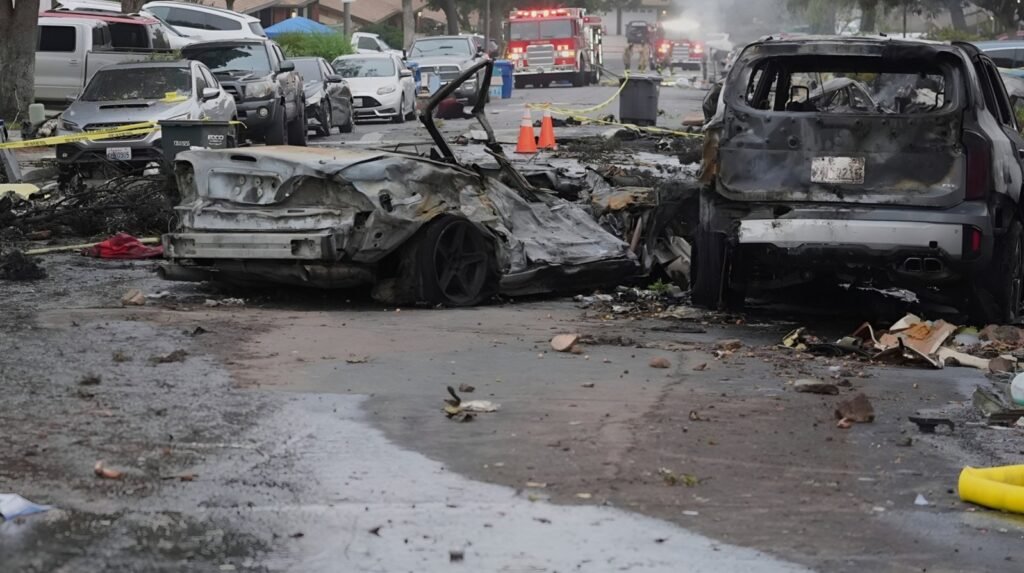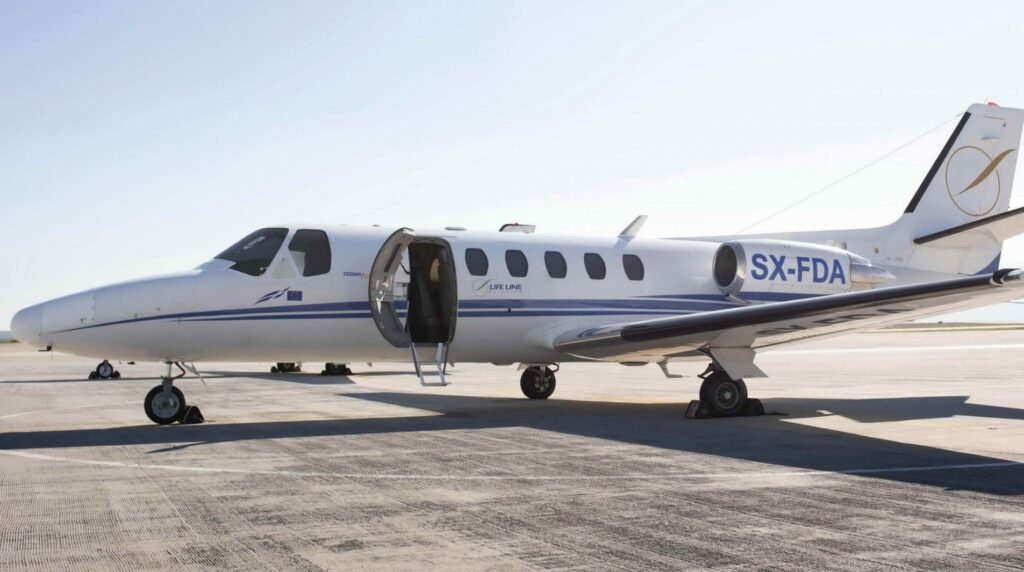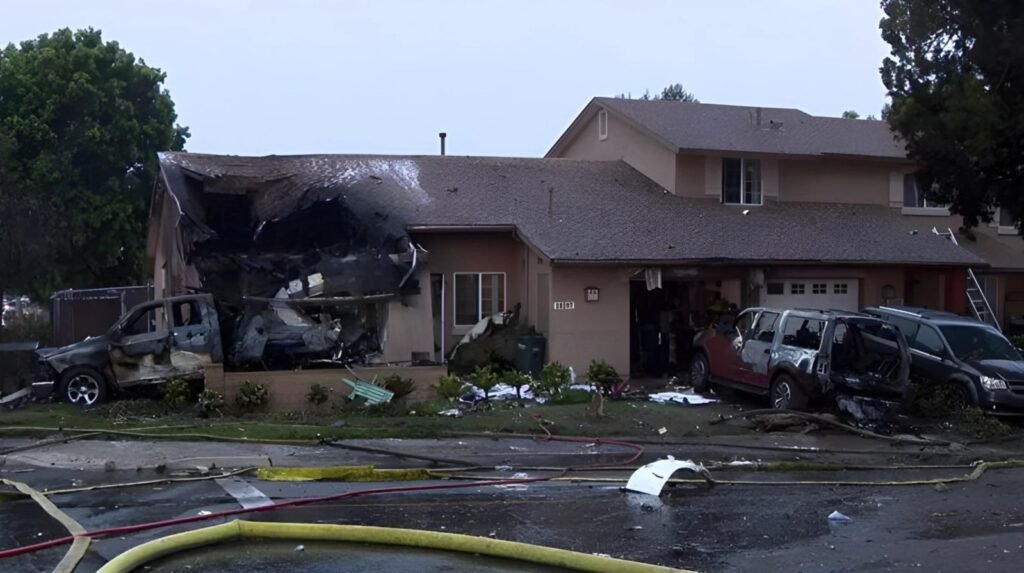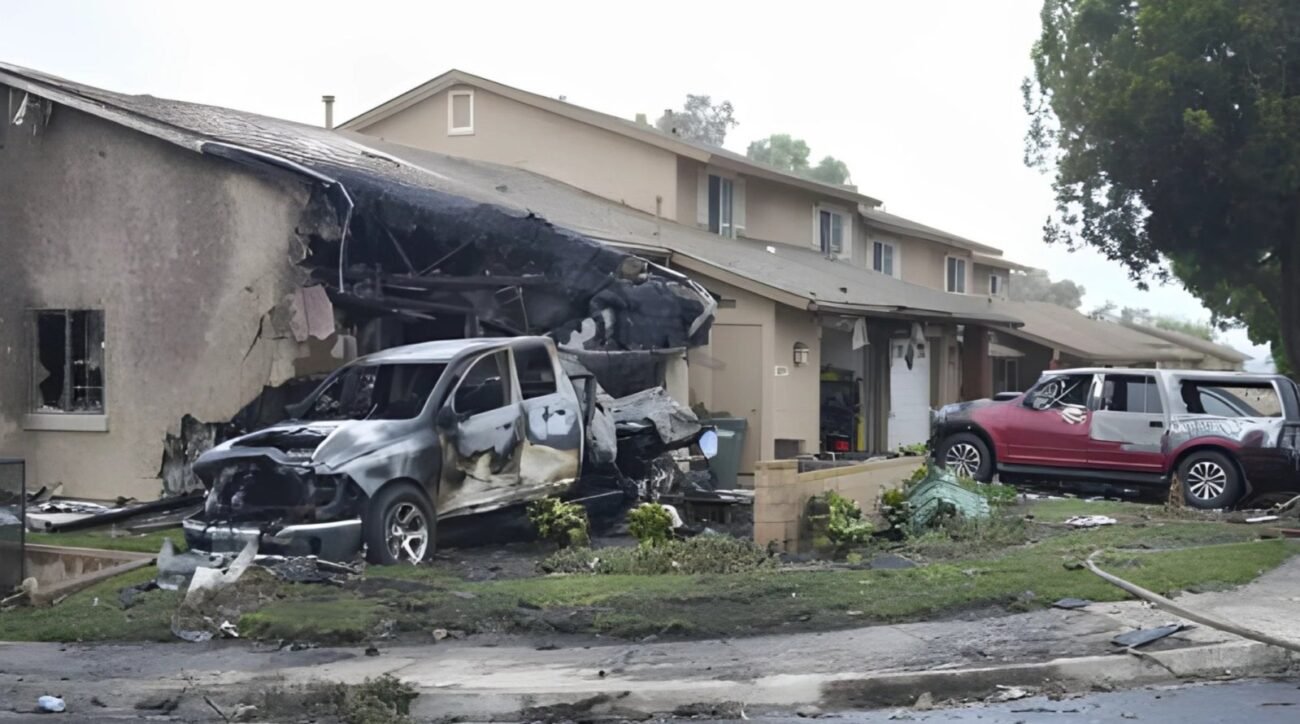In the predawn darkness of 22 May 2025, the San Diego Cessna 550 crash shattered the calm of Murphy Canyon. Six lives were lost including renowned music agent Dave Shapiro and former The Devil Wears Prada drummer Daniel Williams when the 1985 Cessna 550 Citation II (tail number N666DS) clipped high-tension lines and plunged into a Navy-owned housing complex just two miles short of Montgomery-Gibbs Executive Airport. Thick fog, a demanding overnight itinerary and the absence of a staffed control tower coalesced into one of Southern California’s deadliest recent general-aviation accidents

Timeline of the Final Flight
Departure and Refuelling
- 21 May 2025, 23:15 EDT N666DS departs Teterboro, New Jersey, on an IFR flight plan destined for San Diego.
- 22 May, 01:10 CDT The crew refuels at Colonel James Jabara Airport in Wichita, Kansas, before pushing west once more
Approach in Heavy Fog
San Diego’s National Weather Service office logged half-mile visibility and a 300-foot overcast ceiling at 03:40 PDT. Under Instrument Flight Rules, the single-pilot crew (Shapiro) relied entirely on avionics for lateral and vertical guidance into runway 28
The Impact Sequence
At 03:44, eyewitnesses saw an orange flash as the right wing struck 12-kV distribution lines above Salmon Street. Jet-A fuel rained onto cars, igniting a “river of fire” that destroyed one home and damaged at least ten others. Radar contact ceased at 725 ft AGL; the wreckage came to rest in three main debris fields

The Aircraft and Flight Crew
Cessna 550 Citation II
The Cessna 550 is a twin-engine business jet certificated for single-pilot operations, cruising at Mach 0.52 and capable of carrying ten occupants. N666DS had 7,600 airframe hours well within its design life and a fresh annual inspection logged in March 2025.
Pilot-in-Command: Dave Shapiro
Shapiro, 42, held an Airline Transport Pilot rating with 3,200 total hours and 600 in type. A flight instructor and owner of Velocity Aviation, he regularly ferried artists to shows, blending his twin passions for music and aviation.
Right-Seat Passenger: Daniel Williams
Williams, 39, was not licensed but occupied the co-pilot seat for the transcontinental journey. Social-media posts from the cockpit hours earlier underscored the crew’s fatigue-inducing schedule.

Weather and Environmental Factors
A dense marine layer blanketed San Diego County, obscuring visual cues on short final. Low-level wind shear advisories were in effect, and with the airport tower closed overnight, pilots self-announced on CTAF. Such “black-hole” approaches, with little ground lighting beyond the runway threshold, are notorious for inducing glide-path illusions and Controlled Flight Into Terrain (CFIT) events.
The Murphy Canyon crash Victims
Dave Shapiro Independent-Music Visionary
Co-founder of Sound Talent Group and owner of Velocity Records, Shapiro guided acts like Sum 41, Hanson and Parkway Drive. Billboard listed him in its “30 Under 30” in 2012, lauding his role in the rise of independent touring agencies. Industry peers recall a “fearless negotiator” who also BASE-jumped for recreation an adventurer’s spirit that, paradoxically, demanded meticulous preparation.
Daniel Williams From Metalcore to Code
A founding member of The Devil Wears Prada, Daniel Williams drummed on five top-ten Billboard albums before pivoting to tech. After eight years at GoPro, he had just accepted a software-engineering role at Apple a career reinvention cut tragically short.
The Remaining Passengers
Sound Talent Group confirmed two staff members among the dead; the final pair were industry partners whose families sought privacy. All six occupants perished instantly, according to the San Diego Medical Examiner.

Murphy Canyon Crash Damage on the Ground
Murphy Canyon, a sprawling complex of Navy housing, bore the brunt of burning fuel and flying debris. One residence collapsed, its occupants escaping through a rear window; 10–15 others suffered roof loss, shattered windows and smoke infiltration. At least six vehicles were immolated; eight residents required treatment for smoke inhalation or minor cuts. Roughly 100 people spent the next 24 hours at a Red Cross shelter set up at nearby Miller Elementary School.
Evidence Collection
Eight NTSB investigators arrived the same evening, joined by Textron (airframe) and Pratt & Whitney Canada (engine) specialists. The wreckage was relocated to a secure hangar on 24 May for metallurgical analysis and flight-control continuity checks
Key Questions
- Why was the aircraft below the glideslope? Instrument-approach plates set a 3.00-degree path that clears obstacle altitudes by 300 ft.
- Did fatigue impair judgement? The duty day exceeded five hours of single-pilot IFR at night the NTSB’s fatigue threshold.
- Were avionics mis-configured? Incorrect baro-setting or autopilot mode can precipitate altitude deviations.
- Did cockpit distraction contribute? Williams’ presence in the right seat and active social-media use before departure may have diverted focus.
- Could better obstacle-lighting or chart annotations have prevented the strike? Power-line corridors around MYF lack high-visibility ball markers.
Reporting Schedule
The NTSB will post a preliminary factual report within two weeks and a final probable-cause document in 12–18 months.
Community Response and Resilience
San Diego Fire-Rescue deployed 110 firefighters, haz-mat specialists and Navy crews. Their rapid foam attack stopped the fuel blaze from reaching a 500-gallon home-heating tank, averting secondary explosions. Mayor Todd Gloria praised neighbours who banged on doors to wake sleeping families, crediting “civilian courage” for the absence of ground fatalities.
Within 48 hours, local businesses donated clothing, diapers and pet supplies; the Navy Housing Office arranged temporary lodging for displaced families. A GoFundMe campaign surpassed $150,000 in its first day.
Industry Lessons and Safety Recommendations
Mandate Terrain-Warning Systems in Light Jets
CFIT accounts for 17 % of business-jet fatalities; equipping older Citation II aircraft with terrain-awareness (TAWS-B) could slash that figure.
Re-evaluate Single-Pilot Night IFR Operations
Extending Part 135 two-pilot requirements to long cross-country Part 91 flights would add redundancy without prohibitive costs.
Enhance Obstacle Lighting Around Urban Airports
Power companies should fit high-voltage spans inside approach corridors with LED strobe balls, and the FAA should update sectional charts accordingly.
Institute Fatigue-Risk Management for General Aviation
Duty-time guidance similar to airline FAR 117 would help private pilots quantify and mitigate fatigue.
Promote Community Emergency-Response Training
Quick evacuation saved lives; expanding CERT (Community Emergency Response Team) programs could replicate that success nationwide.
Frequently Asked Questions
Q: Was alcohol or drug impairment suspected?
Toxicology results are pending, but NTSB officials noted no evidence of substance misuse at the scene.
Q: Why didn’t ATC intervene sooner?
Montgomery-Gibbs is non-towered from 23:00 to 06:00. Approach control handed the flight off to advisory frequency, standard for GA traffic.
Q: Could passengers have survived with parachutes?
The Citation II lacks an egress system for high-altitude bailout; structural breakup and post-impact fire left no survivable space.
Conclusion
The San Diego Cessna 550 crash stands as a stark reminder that modern avionics and pilot experience cannot always conquer weather, fatigue and urban obstacles. The deaths of Dave Shapiro, Daniel Williams and four colleagues reverberate across music, technology and aviation communities, while the destruction in Murphy Canyon exposes vulnerabilities in low-visibility approach corridors. As investigators dissect every second of the flight, one imperative emerges: translate findings into concrete safety reforms because the ultimate tribute to the six lives lost is a sky made safer for everyone aloft.
Ready to venture beyond the conventional? Our blog is dedicated to unearthing stories that are not only strange but deeply thought-provoking, pushing the boundaries of what you thought possible. If you enjoyed this journey into the unexpected, there’s a whole world of bizarre happenings waiting to be discovered. Continue your exploration now. Explore our blog section for more captivating reads.













